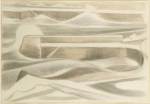Paul Nash (1889–1946) is best known and primarily discussed as a war artist. His most famous paintings in London, by far, are his large wartime masterpieces at the Imperial War Museum (We Are Making a New World, 1918 and The Menin Road 1919) and Tate Britain (Totes Meer, 1941). Nash’s mature career was framed by conflict, and by his own admission the First World War was a major point of rupture both personally and artistically.
There are a few war works on display at Piano Nobile’s current exhibition of the artist’s works on paper. An exceptional set of four sketches made at the Ypres Salient in 1917 (two on loan from the IWM; one, remarkably, for sale) lay down in coloured chalk the acrid scenes Nash described so vividly in a letter home: ‘The rain drives on, the stinking mud becomes more evilly yellow, the shell holes fill up with green white water…the black dying trees ooze & sweat’. Nash wanted his war work to ‘have a bitter truth’, and these deliberately heavy-handed images seem choked with it. They hang alongside the artist’s delicate pre-war watercolour portraits (and they were portraits – Nash spoke tenderly of their different characters) of English trees. The disturbing contrast between their stretching branches, full of life, and the blasted husks that stand dead over the trenches, has been much commented on and is as affecting as ever.
But these works are tucked away at the back of the show – a bold move given the public interest in the centenary – and are not really representative of it, even though they colour its every aspect. Nash described the period after the First World War as ‘another world’, and pursued new artistic directions in the following decades, never returning to the intricacies of his pre-war style and carefully developing the one he became famous for in 1918. It is this peacetime landscape that David Boyd Haycock, the show’s curator, sets out to explore. His impressive selection includes examples of the artist’s austere formal experiments at Dymchurch, as he recovered from the trauma of the conflict; his Surrealist fancies from the 1930s; and his poetically ordered impressions of the English countryside, that seem so straightforward at first glance, but manage to convey a charged sense of place with remarkable economy of means. The fact that the exhibits are all watercolours (which are rarely on public view) means such a tour is full of surprises even for the enthusiast.
Nash’s watercolours from the 1920s and ‘30s breathe easier than his dense wartime sketches, with a lightness of touch that he never achieved (nor, I suspect, attempted) in oils. But they still leave little to chance. Throughout the show, I was struck by the structures that weigh down the artist’s washes: his methodical hatching in pen and pencil, that divides up the page like a tapestry; the ruled edges of his architectural elements; the grids, colour notes and revised outlines sitting visible under thin washes of paint.
This balance between fluidity and tight design was not something I had fully appreciated in Nash’s work before, but it emerges clearly here as a stylistic preference curiously echoed in his choice of subjects. A remarkable number of the studies, for example, feature bodies of water. In his Dymchurch sketches jagged waves crash against an equally unforgiving sea wall with a violence that many have interpreted as reflecting Nash’s psychological state at the time (he suffered a nervous collapse in 1921). In a number of later landscapes the earth and sea seem to have resolved their differences: in Sea Wall (1935) they merge in a sinuous composition of muted browns and greys; Stone Sea (1937) traces the rise and fall of a dry stone wall over rolling hills; in Maiden Castle (1943), the ancient hill fort’s dug-out ramparts seem to break over themselves.
There’s something oddly reasonable about the way Nash’s paintings resolve themselves into compositions of such clarity. Some critics have taken that as a weakness, arguing that the artist’s simplifications are a half-hearted form of modernism. But there’s something compelling in the way Nash casts over his subjects again and again from slightly different angles, attempting to outline elemental subjects while owning up to the limitations of his artistic means. This exhibition manages to be incredibly cohesive and multifaceted at once, and is an excellent introduction to an artist who is so often judged by the first and last chapters of his career.
‘Paul Nash: Watercolours, 1910–1946. Another Life, Another World’ is at Piano Nobile, London, until 22 November.
Related Articles
The Apollo Podcast July/August: The Imperial War Museum Reopens (featuring David Boyd Haycock)
Nevinson’s prints at Osborne Samuel, London (Maggie Gray)
‘British Art at War: Paul Nash’ on BBC Four (Camilla Apcar)
Lasting Legacies: the reopening of the IWM London (Diane Lees)
Apollo Event: ‘Building and the Landscape in Modern British Painting’ (Thomas Marks)








